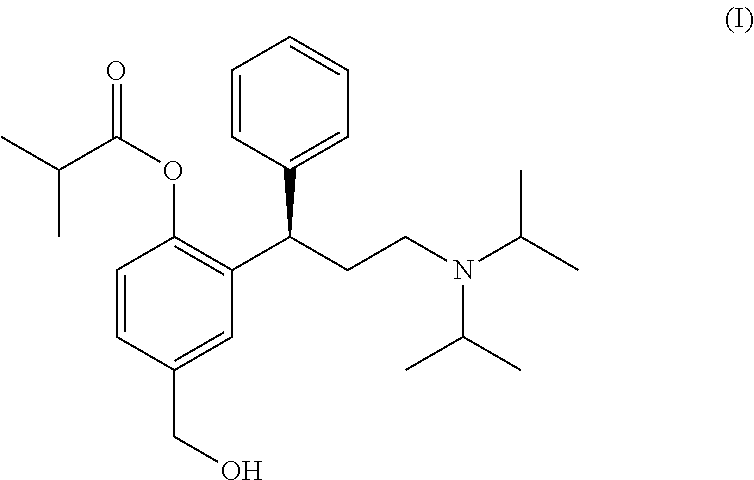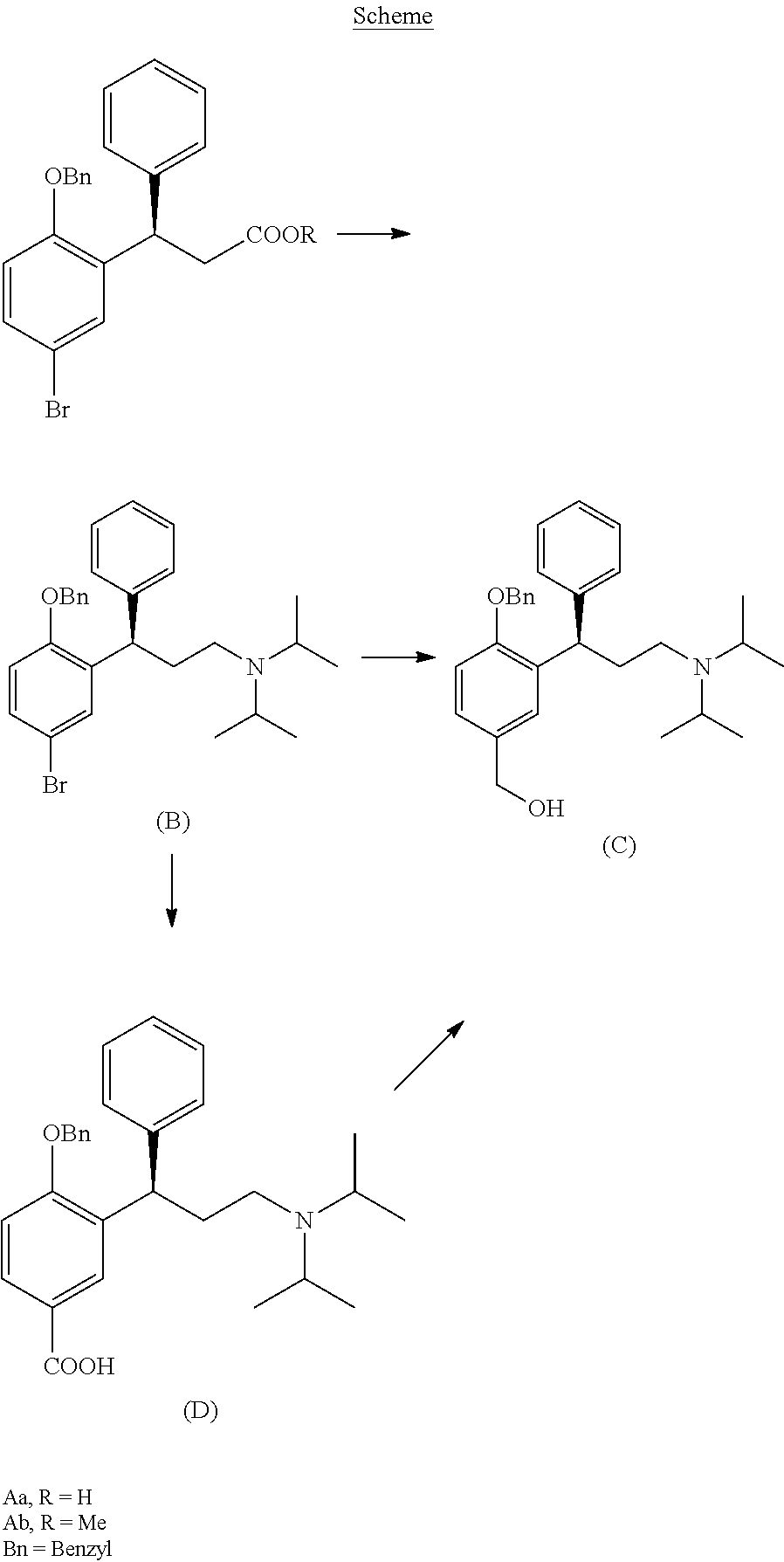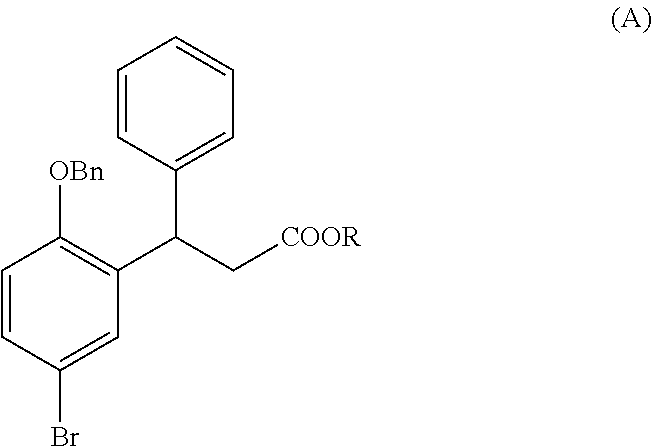Process for the preparation of fesoterodine
- Summary
- Abstract
- Description
- Claims
- Application Information
AI Technical Summary
Benefits of technology
Problems solved by technology
Method used
Image
Examples
example 1
Synthesis of methyl 3-(3-diisopropylamino-1-phenyl-propyl)-4-hydroxy-benzoate (Compound of Formula II)
[0067]Methyl 4-hydroxy-benzoate (52.0 g, 340 mmol) is suspended in methanesulfonic acid (90 ml) in a round-bottom flask under inert atmosphere and the mixture is heated at a temperature of 50-55° C. 3-Diisopropylamino-1-phenyl-propan-1-ol (20.0 g, 85.0 mmol) is slowly added in about 2 hours and the mixture is reacted while hot for 5-6 hours. The mixture is cooled at room temperature and slowly poured in ice / water (200 g) under strong stirring. The product is extracted with dichloromethane (200 ml) and the organic phase is washed with a 10% sodium hydroxide solution (2×100 ml), then with an ammonium chloride aqueous solution until neutral pH. 28.9 g of a product are obtained in 92% yield.
[0068]1H-NMR (300 MHz, CDCl3, 28° C.): δ 7.74 (dd, 1H); 7.50 (d, 1H); 7.34-7.16 (m, 5H); 6.88 (d, 1H); 4.50 (dd, 1H); 3.76 (s, 3H); 3.26 (m, 2H); 2.74 (m, 1H), 2.40 (m, 2H); 2.16 (m, 1H); 1.10 (dd, 1...
example 2
Preparation of the Diastereomeric Salt of a Compound of Formula (II) with (+)-2,3-dibenzoyl-D-tartaric Acid
[0069]Racemic methyl 3-(3-diisopropylamino-1-phenyl-propyl)-4-hydroxy-benzoate (22.0 g, 59.5 mmol) is dissolved in ethanol (320 ml) in a round-bottom flask under inert atmosphere at a temperature of about 60° C. and (+)-2,3-dibenzoyl-D-tartaric acid (11.1 g, 31.0 mmol) is added thereto. The mixture is left to spontaneously cool until room temperature for 16-18 hours and the suspended solid is filtered and washed with ethanol (3×25 ml). The product is dried in a static dryer at 50° C. under reduced pressure to afford 20.4 g of the salt with 95:5 R / S enantiomeric ratio as evaluated by chiral HPLC.
[0070]1H-NMR (300 MHz, DMSO-d6, 28° C.): δ 7.94 (d, 4H); 7.78 (dd, 1H); 7.64-7.56 (m, 3H); 7.45 (t, 4H); 7.28-7.10 (m, 5H); 6.86 (d, 1H); 5.64 (s, 2H); 4.30 (dd, 1H); 3.75 (s, 3H); 3.40 (m, 2H); 2.75-2.50 (m, 2H); 2.25 (m, 2H); 0.96 (dd, 12H).
example 3
Preparation of the Diastereomeric Salt of a Compound of Formula (II) with (−)-2,3-dibenzoyl-L-tartaric Acid
[0071]Racemic methyl 3-(3-diisopropylamino-1-phenyl-propyl)-4-hydroxy-benzoate (22.0 g, 59.5 mmol) is dissolved in ethanol (320 ml) in a round-bottom flask under inert atmosphere at a temperature of about 60° C. and (−)-2,3-dibenzoyl-L-tartaric acid (11.1 g, 31.0 mmol) is added thereto. The mixture is left to spontaneously cool until room temperature for 16-18 hours and the suspended solid is filtered and washed with ethanol (3×25 ml). The product is dried in a static dryer at 50° C. under reduced pressure to afford 20.4 g of the salt with 95:5 S / R enantiomeric ratio as evaluated by chiral HPLC.
[0072]1H-NMR (300 MHz, DMSO-d6, 28° C.): δ 7.94 (d, 4H); 7.78 (dd, 1H); 7.64-7.56 (m, 3H); 7.45 (t, 4H); 7.28-7.10 (m, 5H); 6.86 (d, 1H); 5.64 (s, 2H); 4.30 (dd, 1H); 3.75 (s, 3H); 3.40 (m, 2H); 2.75-2.50 (m, 2H); 2.25 (m, 2H); 0.96 (dd, 12H).
PUM
| Property | Measurement | Unit |
|---|---|---|
| Molar ratio | aaaaa | aaaaa |
| Optical activity | aaaaa | aaaaa |
Abstract
Description
Claims
Application Information
 Login to View More
Login to View More - R&D Engineer
- R&D Manager
- IP Professional
- Industry Leading Data Capabilities
- Powerful AI technology
- Patent DNA Extraction
Browse by: Latest US Patents, China's latest patents, Technical Efficacy Thesaurus, Application Domain, Technology Topic, Popular Technical Reports.
© 2024 PatSnap. All rights reserved.Legal|Privacy policy|Modern Slavery Act Transparency Statement|Sitemap|About US| Contact US: help@patsnap.com










